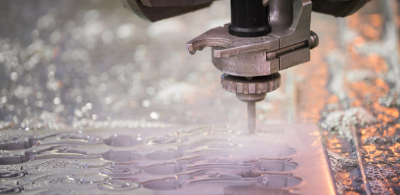Knife Making with Waterjet Cutting
Knife making is an art form that combines craftsmanship, functionality, and beauty. As an aspiring knife maker, you’re continually seeking new techniques to elevate your creations, and waterjet cutting has emerged as a game-changer in the world of knife making.
In this in-depth guide, we’ll explore how waterjet cutting works, why it's a superior choice for cutting knife blanks, and the fascinating science behind this innovative process. So, let's dive into the world of waterjet cutting and discover how it can transform your knife-making.
How Does Waterjet Cutting Work?
Waterjet cutting is a highly precise and efficient method that uses a high-pressure stream of water mixed with an abrasive material, typically garnet, to cut through various materials, including steel. This process relies on the immense kinetic energy of the water-abrasive mixture to slice through the material with minimal heat generation. Here are the primary components of a waterjet cutting system:
- High-pressure pump: This pump generates a high-pressure water flow, which is the driving force behind the cutting process.
- Abrasive delivery system: This component feeds the abrasive material into the water stream, creating a powerful cutting mixture.
- Cutting head: The cutting head houses the nozzle and mixing chamber, where the abrasive and water combine before being expelled at high speed.
- Motion control system: This system guides the cutting head's movement to create intricate and precise cuts based on the input from CAD/CAM software.
Top 3 Reasons Waterjet Cutting Is Superior To Other Cutting Methods
Waterjet cutting has several advantages over traditional cutting methods like laser cutting, plasma cutting, and bandsaw cutting, making it a top choice for knife makers. Here are the top 3 reasons waterjet cutting stands out:
- No Heat-Affected Zones: Waterjet cutting doesn't generate heat during the cutting process, eliminating heat-affected zones (HAZ) that can compromise the steel's properties. This is especially crucial for knife makers, as HAZ can negatively impact the knife's performance and durability.
- Precision and Intricate Cutting: Waterjet cutting offers unparalleled accuracy and intricate cutting capabilities, with tolerances as tight as ±0.001 inches. This level of precision allows knife makers to create intricate patterns and shapes, elevating the knife's design and aesthetic appeal.
- Versatility and Material Compatibility: Waterjet cutting can handle a wide range of materials, including high carbon, stainless, and Damascus steel, giving knife makers the flexibility to work with different materials without changing their cutting method.
Understanding Waterjet Cutting for Knife Makers: From Design to Finished Blank
The process of waterjet cutting a knife blank involves several steps, from designing the knife to cutting the blank from the chosen material. Here's a brief overview of the process:
- Design: Use Knifeprint’s state-of-the-art editor to create any knife design you can imagine in just minutes. Now, with our V2 editor, you don’t have to stop at designing and cutting out blade blanks, you can design and cut handles as well as in a number of different materials.
- Nesting: To maximize material usage and reduce waste, we arrange multiple knife blanks within the steel sheet using nesting techniques.
- Converting to Machine Code: CAM (Computer-Aided Manufacturing) software translates your design into machine code, which guides the waterjet cutter during the cutting process.
- Waterjet Cutting: The high-pressure water-abrasive mixture is directed onto the steel sheet, cutting the knife blanks with precision and minimal waste.

Things We Take Into Consideration When Waterjet Cutting
To ensure success when using waterjet cutting for knife blanks, we’re very careful about keeping a few things in mind:
- Machine Setup and Maintenance: Proper setup and maintenance of the waterjet cutting machines are crucial for smooth operation and precise cutting. We regularly inspect and replace consumable parts, and follow the manufacturer's guidelines for maintenance to extend our equipment's life and maximize precision.
- Mastering CAD/CAM Software and Nesting: Proficiency in CAD/CAM software and nesting techniques gives us the highest degree of efficiency and accuracy in our waterjet cutting process. We invest a lot of time in mastering these tools to optimize your knife-making projects.
- Safety and Environmental Considerations: We always follow safety guidelines and ensure proper ventilation in our workspace. At knifeprint.com, we responsibly dispose of used abrasive material and recycle steel waste when possible.
A Bright Future for Waterjet Cutting in Knife Making
As the knife-making community continues to embrace waterjet cutting, this technology will likely play an increasingly significant role in creating exceptional knives. By harnessing the power of waterjet cutting, knife makers can push the boundaries of design, precision, and material compatibility, producing stunning and functional works of art.
Waterjet cutting has undoubtedly revolutionized the process of cutting knife blanks, offering unparalleled precision, versatility, and heat-free cutting. By understanding the mechanics of this powerful technique and implementing best practices, knife makers can elevate their craft and create remarkable knives. So, if you haven't already, consider adding waterjet cutting to your knife-making toolkit and explore the limitless possibilities it brings. Start by heading over to our online editor and creating your first project!
